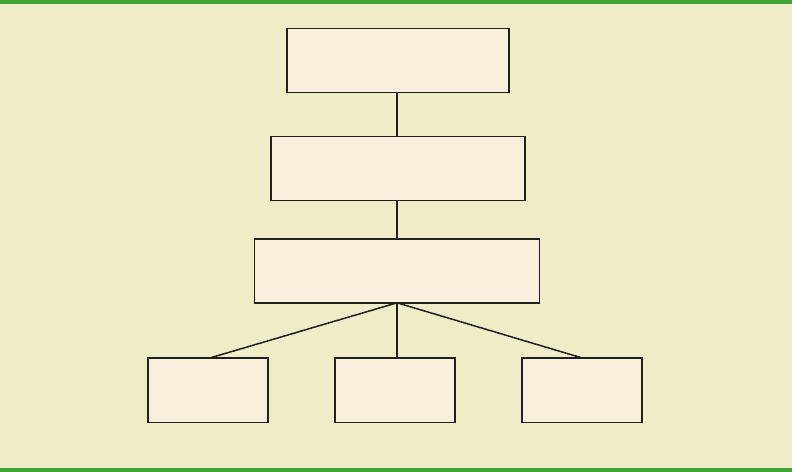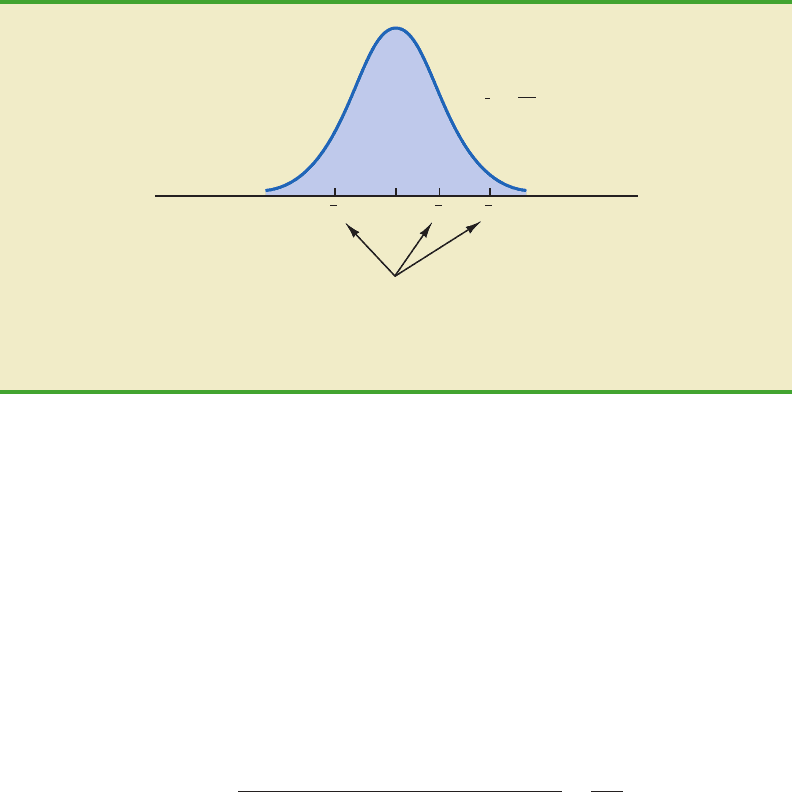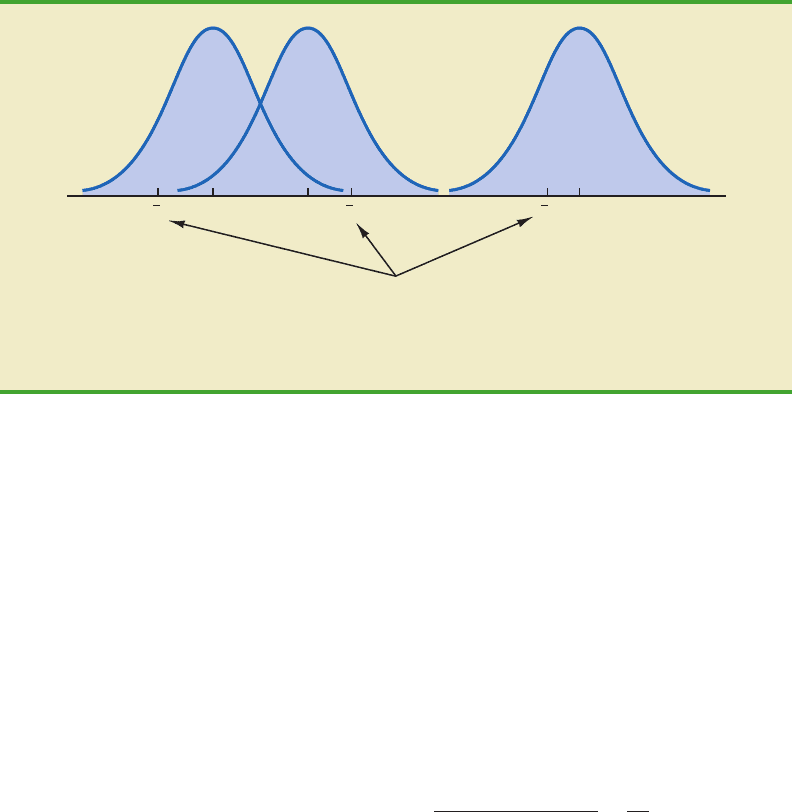Anderson D.R., Sweeney D.J., Williams T.A. Essentials of Statistics for Business and Economics
Подождите немного. Документ загружается.

the data. An experiment begins with identifying a variable of interest. Then one or more
other variables, thought to be related, are identified and controlled, and data are collected
about how those variables influence the variable of interest.
In an observational study, data are usually obtained through sample surveys and not a
controlled experiment. Good sample designs are employed, but the rigorous controls asso-
ciated with an experimental statistical study are often not possible. For instance, in a study of
the relationship between smoking and lung cancer the researcher cannot assign a smoking
habit to subjects. The researcher is restricted to simply observing the effects of smoking on
people who already smoke and the effects of not smoking on people who already do not
smoke.
In this section we introduce the basic principles of an experimental study and show how
they are used in a completely randomized design. We also provide a conceptual overview
of the statistical procedure called analysis of variance (ANOVA). In the following section
we show how ANOVAcan be used to test for the equality of k population means using data
obtained from a completely randomized design as well as data obtained from an observa-
tional study. So, in this sense, ANOVAextends the statistical material in the preceding sec-
tions from two population means to three or more population means. In later chapters, we
will see that ANOVA plays a key role in analyzing the results of regression studies involv-
ing both experimental and observational data.
As an example of an experimental statistical study, let us consider the problem facing
Chemitech, Inc. Chemitech developed a new filtration system for municipal water supplies.
The components for the new filtration system will be purchased from several suppliers, and
Chemitech will assemble the components at its plant in Columbia, South Carolina. The in-
dustrial engineering group is responsible for determining the best assembly method for the
new filtration system. After considering a variety of possible approaches, the group narrows
the alternatives to three: method A, method B, and method C. These methods differ in the
sequence of steps used to assemble the system. Managers at Chemitech want to determine
which assembly method can produce the greatest number of filtration systems per week.
In the Chemitech experiment, assembly method is the independent variable or factor.
Because three assembly methods correspond to this factor, we say that three treatments are
associated with this factor; each treatment corresponds to one of the three assembly meth-
ods. The Chemitech problem is an example of a single-factor experiment; it involves one
qualitative factor (method of assembly). More complex experiments may consist of multi-
ple factors; some factors may be qualitative and others may be quantitative.
The three assembly methods or treatments define the three populations of interest for
the Chemitech experiment. One population is all Chemitech employees who use assembly
methodA,anotheristhosewhousemethodB,andthethirdisthosewhousemethodC.Note
thatfor each population the dependent or response variable isthenumber of filtration sys-
tems assembled per week, and the primary statistical objective of the experiment is to
determine whether the mean number of units produced per week is the same for all three
populations (methods).
Suppose a random sample of three employees is selected from all assembly workers at
the Chemitech production facility. In experimental design terminology, the three randomly
selected workers are the experimental units. The experimental design that we will use for
the Chemitech problem is called a completely randomized design. This type of design
requires that each of the three assembly methods or treatments be assigned randomly to one
of the experimental units or workers. For example, method A might be randomly assigned
to the second worker, method B to the first worker, and method C to the third worker. The
concept of randomization, as illustrated in this example, is an important principle of all
experimental designs.
Note that this experiment would result in only one measurement or number of units
assembled for each treatment. To obtain additional data for each assembly method, we
10.4 An Introduction to Experimental Design and Analysis of Variance 415
Sir Ronald Alymer Fisher
(1890–1962) invented the
branch of statistics known
as experimental design.
In addition to being
accomplished in statistics,
he was a noted scientist in
the field of genetics.
Cause-and-effect
relationships can be
difficult to establish in
observational studies; such
relationships are easier to
establish in experimental
studies.
Randomization is the
process of assigning the
treatments to the
experimental units at
random. Prior to the work
of Sir R. A. Fisher,
treatments were assigned
on a systematic or
subjective basis.
CH010.qxd 8/16/10 7:49 PM Page 415
Copyright 2010 Cengage Learning. All Rights Reserved. May not be copied, scanned, or duplicated, in whole or in part. Due to electronic rights, some third party content may be suppressed from the eBook and/or eChapter(s).
Editorial review has deemed that any suppressed content does not materially affect the overall learning experience. Cengage Learning reserves the right to remove additional content at any time if subsequent rights restrictions require it.

416 Chapter 10 Comparisons Involving Means, Experimental Design, and Analysis of Variance
must repeat or replicate the basic experimental process. Suppose, for example, that instead
of selecting just three workers at random we selected 15 workers and then randomly assigned
each of the three treatments to 5 of the workers. Because each method of assembly is
assigned to 5 workers, we say that five replicates have been obtained. The process of repli-
cation is another important principle of experimental design. Figure 10.3 shows the com-
pletely randomized design for the Chemitech experiment.
Data Collection
Once we are satisfied with the experimental design, we proceed by collecting and analyz-
ing the data. In the Chemitech case, the employees would be instructed in how to per-
form the assembly method assigned to them and then would begin assembling the new
filtration systems using that method. After this assignment and training, the number of
units assembled by each employee during one week is as shown in Table 10.3. The sample
means, sample variances, and sample standard deviations for each assembly method are
also provided. Thus, the sample mean number of units produced using methodAis 62; the
sample mean using method B is 66; and the sample mean using method C is 52. From
these data, method B appears to result in higher production rates than either of the other
methods.
The real issue is whether the three sample means observed are different enough for us
to conclude that the means of the populations corresponding to the three methods of as-
sembly are different. To write this question in statistical terms, we introduce the following
notation.
μ
1
mean number of units produced per week using method A
μ
2
mean number of units produced per week using method B
μ
3
mean number of units produced per week using method C
Employees at the plant in
Columbia, South Carolina
Random sample of 15 employees
is selected for the experiment
Method B
n
2
= 5
Method A
n
1
= 5
Method C
n
3
= 5
Each of the three assembly methods
is randomly assigned to 5 employees
FIGURE 10.3 COMPLETELY RANDOMIZED DESIGN FOR EVALUATING
THE CHEMITECH ASSEMBLY METHOD EXPERIMENT
CH010.qxd 8/16/10 7:49 PM Page 416
Copyright 2010 Cengage Learning. All Rights Reserved. May not be copied, scanned, or duplicated, in whole or in part. Due to electronic rights, some third party content may be suppressed from the eBook and/or eChapter(s).
Editorial review has deemed that any suppressed content does not materially affect the overall learning experience. Cengage Learning reserves the right to remove additional content at any time if subsequent rights restrictions require it.

10.4 An Introduction to Experimental Design and Analysis of Variance 417
Although we will never know the actual values of μ
1
, μ
2
, and μ
3
, we want to use the sample
means to test the following hypotheses.
As we will demonstrate shortly, analysis of variance (ANOVA) is the statistical procedure
used to determine whether the observed differences in the three sample means are large
enough to reject H
0
.
Assumptions for Analysis of Variance
Three assumptions are required to use analysis of variance.
1. Foreach population, the response variable is normally distributed. Implication:
In the Chemitech experiment the number of units produced per week (response variable)
must be normally distributed for each assembly method.
2. The variance of the response variable, denoted σ
2
, is the same for all of the pop-
ulations. Implication: In the Chemitech experiment, the variance of the number of
units produced per week must be the same for each assembly method.
3. The observations must be independent. Implication: In the Chemitech experiment,
the number of units produced per week for each employee must be independent of
the number of units produced per week for any other employee.
Analysis of Variance: A Conceptual Overview
If the means for the three populations are equal, we would expect the three sample means
to be close together. In fact, the closer the three sample means are to one another, the
more evidence we have for the conclusion that the population means are equal. Alterna-
tively, the more the sample means differ, the more evidence we have for the conclusion
that the population means are not equal. In other words, if the variability among the sam-
ple means is “small,” it supports H
0
; if the variability among the sample means is “large,”
it supports H
a
.
If the null hypothesis, H
0
: μ
1
μ
2
μ
3
, is true, we can use the variability among the
sample means to develop an estimate of σ
2
. First, note that if the assumptions for analysis
of variance are satisfied, each sample will have come from the same normal distribution
with mean μ and variance σ
2
. Recall from Chapter 7 that the sampling distribution of the
H
0
:
H
a
:
μ
1
μ
2
μ
3
Not all population means are equal
Method
ABC
58 58 48
64 69 57
55 71 59
66 64 47
67 68 49
Sample mean 62 66 52
Sample variance 27.5 26.5 31.0
Sample standard deviation 5.244 5.148 5.568
TABLE 10.3
NUMBER OF UNITS PRODUCED BY 15 WORKERS
file
W
EB
Chemitech
If H
0
is rejected, we cannot
conclude that all
population means are
different. Rejecting H
0
means that at least two
population means have
different values.
If the sample sizes are
equal, analysis of variance
is not sensitive to
departures from the
assumption of normally
distributed populations.
CH010.qxd 8/16/10 7:49 PM Page 417
Copyright 2010 Cengage Learning. All Rights Reserved. May not be copied, scanned, or duplicated, in whole or in part. Due to electronic rights, some third party content may be suppressed from the eBook and/or eChapter(s).
Editorial review has deemed that any suppressed content does not materially affect the overall learning experience. Cengage Learning reserves the right to remove additional content at any time if subsequent rights restrictions require it.

418 Chapter 10 Comparisons Involving Means, Experimental Design, and Analysis of Variance
sample mean for a simple random sample of size n from a normal population will be nor-
mally distributed with mean μ and variance σ
2
/n. Figure 10.4 illustrates such a sampling
distribution.
Thus, if the null hypothesis is true, we can think of each of the three sample means,
1
62,
2
66, and
3
52 from Table 10.3, as values drawn at random from the sam-
pling distribution shown in Figure 10.4. In this case, the mean and variance of the three
values can be used to estimate the mean and variance of the sampling distribution. When
the sample sizes are equal, as in the Chemitech experiment, the best estimate of the mean
of the sampling distribution of is the mean or average of the sample means. Thus, in the
Chemitech experiment, an estimate of the mean of the sampling distribution of is
(62 66 52)/3 60. We refer to this estimate as the overall sample mean. An estimate
of the variance of the sampling distribution of , , is provided by the variance of the three
sample means.
Because σ
2
/n, solving for σ
2
gives
Hence,
The result, 260, is referred to as the between-treatments estimate of σ
2
.
The between-treatments estimate of σ
2
is based on the assumption that the null hypoth-
esis is true. In this case, each sample comes from the same population, and there is only
one sampling distribution of . To illustrate what happens when H
0
is false, suppose the
population means all differ. Note that because the three samples are from normal popu-
lations with different means, they will result in three different sampling distributions.
Figure 10.5 shows that in this case, the sample means are not as close together as they were
x¯
ns
2
x
¯
Estimate of σ
2
n (Estimate of σ
2
x
¯
) ns
2
x
¯
5(52) 260
σ
2
nσ
2
x
¯
σ
2
x
¯
s
2
x
¯
(62 60)
2
(66 60)
2
(52 60)
2
3 1
104
2
52
σ
2
x
¯
x¯
x¯
x¯
x¯
x¯x¯x¯
x¯
2
x
1
Sample means are “close
together” because there is only
one sampling distribution
when H
0
is true
μ
x
2
x
3
=
n
σ
x
2
σ
FIGURE 10.4 SAMPLING DISTRIBUTION OF GIVEN H
0
IS TRUEx¯
CH010.qxd 8/16/10 7:49 PM Page 418
Copyright 2010 Cengage Learning. All Rights Reserved. May not be copied, scanned, or duplicated, in whole or in part. Due to electronic rights, some third party content may be suppressed from the eBook and/or eChapter(s).
Editorial review has deemed that any suppressed content does not materially affect the overall learning experience. Cengage Learning reserves the right to remove additional content at any time if subsequent rights restrictions require it.

10.4 An Introduction to Experimental Design and Analysis of Variance 419
μ
1
x
2
x
1
x
3
μ
3
μ
2
Sample means come from
different sampling distributions
and are not as close together when
H
0
is false
FIGURE 10.5 SAMPLING DISTRIBUTIONS OF GIVEN H
0
IS FALSEx¯
when H
0
was true. Thus, will be larger, causing the between-treatments estimate of σ
2
to be larger. In general, when the population means are not equal, the between-treatments
estimate will overestimate the population variance σ
2
.
The variation within each of the samples also has an effect on the conclusion we reach
in analysis of variance. When a random sample is selected from each population, each of
the sample variances provides an unbiased estimate of σ
2
. Hence, we can combine or pool
the individual estimates of σ
2
into one overall estimate. The estimate of σ
2
obtained in this
way is called the pooled or within-treatments estimate of σ
2
. Because each sample
variance provides an estimate of σ
2
based only on the variation within each sample, the
within-treatments estimate of σ
2
is not affected by whether the population means are equal.
When the sample sizes are equal, the within-treatments estimate of σ
2
can be obtained by
computing the average of the individual sample variances. For the Chemitech experiment
we obtain
In the Chemitech experiment, the between-treatments estimate of σ
2
(260) is much
larger than the within-treatments estimate of σ
2
(28.33). In fact, the ratio of these two
estimates is 260/28.33 9.18. Recall, however, that the between-treatments approach
provides a good estimate of σ
2
only if the null hypothesis is true; if the null hypothesis
is false, the between-treatments approach overestimates σ
2
. The within-treatments ap-
proach provides a good estimate of σ
2
in either case. Thus, if the null hypothesis is true,
the two estimates will be similar and their ratio will be close to 1. If the null hypothesis
is false, the between-treatments estimate will be larger than the within-treatments estimate,
and their ratio will be large. In the next section we will show how large this ratio must
be to reject H
0
.
In summary, the logic behind ANOVA is based on the development of two independent
estimates of the common population variance σ
2
. One estimate of σ
2
is based on the vari-
ability among the sample means themselves, and the other estimate of σ
2
is based on the
variability of the data within each sample. By comparing these two estimates of σ
2
, we will
be able to determine whether the population means are equal.
Within-treatments estimate of σ
2
27.5 26.5 31.0
3
85
3
28.33
s
2
x¯
CH010.qxd 8/16/10 7:49 PM Page 419
Copyright 2010 Cengage Learning. All Rights Reserved. May not be copied, scanned, or duplicated, in whole or in part. Due to electronic rights, some third party content may be suppressed from the eBook and/or eChapter(s).
Editorial review has deemed that any suppressed content does not materially affect the overall learning experience. Cengage Learning reserves the right to remove additional content at any time if subsequent rights restrictions require it.

420 Chapter 10 Comparisons Involving Means, Experimental Design, and Analysis of Variance
NOTES AND COMMENTS
1. Randomization in experimental design is the
analog of probability sampling in an observa-
tional study.
2. In many medical experiments, potential bias
is eliminated by using a double-blind experi-
mental design. With this design, neither the
physician applying the treatment nor the sub-
ject knows which treatment is being applied.
Many other types of experiments could bene-
fit from this type of design.
3. In this section we provided a conceptual
overview of how analysis of variance can be
used to test for the equality of k population
means for a completely randomized experi-
mental design. We will see that the same pro-
cedure can also be used to test for the equality
of k population means for an observational or
nonexperimental study.
4. In Sections 10.1 and 10.2 we presented statis-
tical methods for testing the hypothesis that the
means of two populations are equal.
ANOVA
can also be used to test the hypothesis that the
means of two populations are equal. In prac-
tice, however, analysis of variance is usually
not used except when dealing with three or
more population means.
10.5 Analysis of Variance and the Completely
Randomized Design
In this section we show how analysis of variance can be used to test for the equality of k
population means for a completely randomized design. The general form of the hypotheses
tested is
where
We assume that a simple random sample of size n
j
has been selected from each of the k popu-
lations or treatments. For the resulting sample data, let
The formulas for the sample mean and sample variance for treatment j are as follow.
(10.10)
x¯
j
兺
n
j
i1
x
ij
n
j
x
ij
n
j
x¯
j
s
2
j
s
j
value of observation i for treatment j
number of observations for treatment j
sample mean for treatment j
sample variance for treatment j
sample standard deviation for treatment j
μ
j
mean of the jth population
H
0
:
H
a
:
μ
1
μ
2
. . .
μ
k
Not all population means are equal
CH010.qxd 8/16/10 7:49 PM Page 420
Copyright 2010 Cengage Learning. All Rights Reserved. May not be copied, scanned, or duplicated, in whole or in part. Due to electronic rights, some third party content may be suppressed from the eBook and/or eChapter(s).
Editorial review has deemed that any suppressed content does not materially affect the overall learning experience. Cengage Learning reserves the right to remove additional content at any time if subsequent rights restrictions require it.

10.5 Analysis of Variance and the Completely Randomized Design 421
(10.11)
The overall sample mean, denoted , is the sum of all the observations divided by the total
number of observations. That is,
(10.12)
where
(10.13)
If the size of each sample is n, n
T
kn; in this case equation (10.12) reduces to
(10.14)
In other words, whenever the sample sizes are the same, the overall sample mean is just the
average of the k sample means.
Because each sample in the Chemitech experiment consists of n 5 observations, the
overall sample mean can be computed by using equation (10.14). For the data in Table 10.3
we obtained the following result.
If the null hypothesis is true (μ
1
μ
2
μ
3
μ), the overall sample mean of 60 is the best
estimate of the population mean μ.
Between-Treatments Estimate of Population Variance
In the preceding section, we introduced the concept of a between-treatments estimate of σ
2
and showed how to compute it when the sample sizes were equal. This estimate of σ
2
is
called the mean square due to treatments and is denoted MSTR. The general formula for
computing MSTR is
(10.15)
The numerator in equation (10.15) is called the sum of squares due to treatments and is
denoted SSTR. The denominator, k 1, represents the degrees of freedom associated with
SSTR. Hence, the mean square due to treatments can be computed using the following
formula.
MSTR
兺
k
j1
n
j
(x¯
j
x¯
¯
)
2
k 1
x¯
¯
62 66 52
3
60
x¯
¯
兺
k
j1
兺
n
j
i1
x
ij
kn
兺
k
j1
兺
n
j
i1
x
ij
兾n
k
兺
k
j1
x¯
j
k
n
T
n
1
n
2
. . .
n
k
x¯
¯
兺
k
j1
兺
n
j
i1
x
ij
n
T
x¯
¯
s
2
j
兺
n
j
i1
(x
ij
x¯
j
)
2
n
j
1
CH010.qxd 8/16/10 7:49 PM Page 421
Copyright 2010 Cengage Learning. All Rights Reserved. May not be copied, scanned, or duplicated, in whole or in part. Due to electronic rights, some third party content may be suppressed from the eBook and/or eChapter(s).
Editorial review has deemed that any suppressed content does not materially affect the overall learning experience. Cengage Learning reserves the right to remove additional content at any time if subsequent rights restrictions require it.

422 Chapter 10 Comparisons Involving Means, Experimental Design, and Analysis of Variance
MEAN SQUARE DUE TO TREATMENTS
(10.16)
where
(10.17)SSTR
兺
k
j1
n
j
(x¯
j
x¯
¯
)
2
MSTR
SSTR
k 1
If H
0
is true, MSTR provides an unbiased estimate of σ
2
. However, if the means of the k
populations are not equal, MSTR is not an unbiased estimate of σ
2
; in fact, in that case,
MSTR should overestimate σ
2
.
For the Chemitech data in Table 10.3, we obtain the following results.
Within-Treatments Estimate of Population Variance
Earlier, we introduced the concept of a within-treatments estimate of σ
2
and showed how
to compute it when the sample sizes were equal. This estimate of σ
2
is called the mean
square due to error and is denoted MSE. The general formula for computing MSE is
(10.18)
The numerator in equation (10.18) is called the sum of squares due to error and is denoted
SSE. The denominator of MSE is referred to as the degrees of freedom associated with SSE.
Hence, the formula for MSE can also be stated as follows.
MSE
兺
k
j1
(n
j
1)s
2
j
n
T
k
MSTR
SSTR
k 1
520
2
260
SSTR
兺
k
j1
n
j
(x¯
j
x¯
¯
)
2
5(62 60)
2
5(66 60)
2
5(52 60)
2
520
MEAN SQUARE DUE TO ERROR
(10.19)
where
(10.20)
SSE
兺
k
j1
(n
j
1)s
2
j
MSE
SSE
n
T
k
Note that
MSE is based on the variation within each of the treatments; it is not influenced by
whether the null hypothesis is true. Thus, MSE always provides an unbiased estimate of σ
2
.
For the Chemitech data in Table 10.3 we obtain the following results.
MSE
SSE
n
T
k
340
15 3
340
12
28.33
SSE
兺
k
j1
(n
j
1)s
2
j
(5 1)27.5 (5 1)26.5 (5 1)31 340
CH010.qxd 8/16/10 7:49 PM Page 422
Copyright 2010 Cengage Learning. All Rights Reserved. May not be copied, scanned, or duplicated, in whole or in part. Due to electronic rights, some third party content may be suppressed from the eBook and/or eChapter(s).
Editorial review has deemed that any suppressed content does not materially affect the overall learning experience. Cengage Learning reserves the right to remove additional content at any time if subsequent rights restrictions require it.

10.5 Analysis of Variance and the Completely Randomized Design 423
Comparing the Variance Estimates: The F Test
If the null hypothesis is true, MSTR and MSE provide two independent, unbiased estimates
of σ
2
. If the ANOVA assumptions are also valid, the sampling distribution of MSTR/MSE
is an F distribution with numerator degrees of freedom equal to k 1 and denominator
degrees of freedom equal to n
T
k. The general shape of the F distribution is shown in
Figure 10.6. If the null hypothesis is true, the value of MSTR/MSE should appear to have
been selected from this F distribution.
However, if the null hypothesis is false, the value of MSTR/MSE will be inflated be-
cause MSTRoverestimates σ
2
. Hence, we will reject H
0
if the resulting value of MSTR/MSE
appears to be too large to have been selected from an F distribution with k 1 numerator
degrees of freedom and n
T
k denominator degrees of freedom. Because the decision to
reject H
0
is based on the value of MSTR/MSE, the test statistic used to test for the equality
of k population means is as follows.
TEST STATISTIC FOR THE EQUALITY OF k POPULATION MEANS
(10.21)
The test statistic follows an F distribution with k 1 degrees of freedom in the
numerator and n
T
k degrees of freedom in the denominator.
F
MSTR
MSE
Let us return to the Chemitech experiment and use a level of significance α .05 to
conduct the hypothesis test. The value of the test statistic is
The
numerator degrees of freedom is k 1 3 1 2 and the denominator degrees of
freedom is n
T
k 15 3 12. Because we will only reject the null hypothesis for large
values of the test statistic, the p-value is the upper tail area of the F distribution corre-
sponding to the value of the test statistic F 9.18. Figure 10.6 shows the sampling distrib-
ution of F MSTR/ MSE, the value of the test statistic, and the upper tail area that is the
p-value for the hypothesis test.
F
MSTR
MSE
260
28.33
9.18
F = 9.18
MSTR/MSE
p-value
Sampling distribution
of MSTR/MSE
FIGURE 10.6 COMPUTATION OF p-VALUE USING THE SAMPLING DISTRIBUTION
OF MSTR/MSE
CH010.qxd 8/16/10 7:49 PM Page 423
Copyright 2010 Cengage Learning. All Rights Reserved. May not be copied, scanned, or duplicated, in whole or in part. Due to electronic rights, some third party content may be suppressed from the eBook and/or eChapter(s).
Editorial review has deemed that any suppressed content does not materially affect the overall learning experience. Cengage Learning reserves the right to remove additional content at any time if subsequent rights restrictions require it.

424 Chapter 10 Comparisons Involving Means, Experimental Design, and Analysis of Variance
From Table 4 of Appendix B we find the following areas in the upper tail of an F dis-
tribution with 2 numerator degrees of freedom and 12 denominator degrees of freedom.
Area in Upper Tail .10 .05 .025 .01
F Value (df
1
ⴝ 2, df
2
ⴝ 12) 2.81 3.89 5.10 6.93
F 9.18
Because F 9.18 is greater than 6.93, the area in the upper tail at F 9.18 is less than .01.
Thus, the p-value is less than .01. Minitab or Excel can be used to show that the exact p-value
is .004. With p-value α .05, H
0
is rejected. The test provides sufficient evidence to
conclude that the means of the three populations are not equal. In other words, analysis of
variance supports the conclusion that the population mean number of units produced per
week for the three assembly methods are not equal.
As with other hypothesis testing procedures, the critical value approach may also be
used. With α .05, the critical F value occurs with an area of .05 in the upper tail of
an F distribution with 2 and 12 degrees of freedom. From the F distribution table, we
find F
.05
3.89. Hence, the appropriate upper tail rejection rule for the Chemitech
experiment is
With F 9.18, we reject H
0
and conclude that the means of the three populations are not
equal. A summary of the overall procedure for testing for the equality of k population means
follows.
Reject H
0
if F 3.89
Appendix F shows how to
compute p-values using
Minitab or Excel.
TEST FOR THE EQUALITY OF k POPULATION MEANS
TEST STATISTIC
REJECTION RULE
where the value of F
α
is based on an F distribution with k 1 numerator degrees of
freedom and n
T
k denominator degrees of freedom.
p-value approach:
Critical value approach:
Reject H
0
if p-value α
Reject H
0
if F F
α
F
MSTR
MSE
H
0
:
H
a
:
μ
1
μ
2
. . .
μ
k
Not all population means are equal
ANOVA Table
The results of the preceding calculations can be displayed conveniently in a table referred
to as the analysis of variance or ANOVA table. The general form of the ANOVA table for
a completely randomized design is shown in Table 10.4; Table 10.5 is the corresponding
ANOVAtable for the Chemitech experiment. The sum of squares associated with the source
of variation referred to as “Total” is called the total sum of squares (SST). Note that the re-
sults for the Chemitech experiment suggest that SST SSTR SSE, and that the degrees
CH010.qxd 8/16/10 7:49 PM Page 424
Copyright 2010 Cengage Learning. All Rights Reserved. May not be copied, scanned, or duplicated, in whole or in part. Due to electronic rights, some third party content may be suppressed from the eBook and/or eChapter(s).
Editorial review has deemed that any suppressed content does not materially affect the overall learning experience. Cengage Learning reserves the right to remove additional content at any time if subsequent rights restrictions require it.
